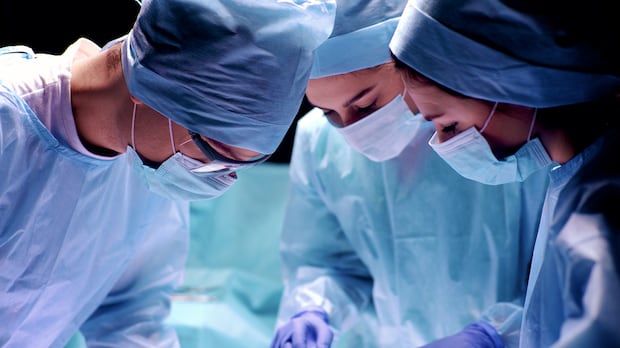Education
Anatomy Program Faces Challenges After Cadaver Use Suspension

Dalhousie University in Halifax has temporarily halted the use of cadavers in its anatomy program due to elevated formaldehyde levels discovered in the Tupper Building’s laboratory. The decision follows air quality tests conducted over the summer, which revealed formaldehyde concentrations exceeding acceptable limits in Nova Scotia. As a result, the university will rely on alternative teaching methods, such as videos, skeletal materials, and anatomical models, for the current academic year.
The suspension of cadaver use has sparked discussions among anatomy professors about the importance of hands-on experience in medical education. Jessica Byram, an associate professor of anatomy at the Indiana University School of Medicine, shared her perspective on the matter. Byram, who credits her initial experience working with donor bodies for her decision to pursue a career in anatomy, believes that engaging with cadavers is crucial for understanding the human body. “We always call our donors our students’ first patient,” she emphasized.
The emotional impact of interacting with real human bodies is profound, according to Byram. She noted that students can observe the physical effects of lifestyle choices, such as smoking, on human anatomy. This firsthand experience, she argues, fosters a deeper understanding of the human condition and the responsibilities that come with being a healthcare provider.
In contrast, some educators, including Derek Harmon from Ohio State University, advocate for the integration of technology in anatomy education. Harmon employs 3D printing and virtual reality tools in his teaching, yet he maintains that these methods cannot fully replicate the experience of working with a cadaver. He posed a thought-provoking analogy: “Imagine if you had a mechanic that was learning to take apart a car and put it back together. Would you want them to learn that just through a computer interface?”
While technology offers valuable supplements to traditional learning, Harmon expressed concern that it may lead to superficial memorization rather than a genuine understanding of anatomy. He believes that a balance must be struck between technological tools and hands-on practice to prepare students adequately for their future roles in medicine.
Byram suggests that students should seek out surgical rotations to gain practical experience, allowing them to appreciate the complexities of human anatomy, such as variations in blood vessel branching and muscle locations. “Being in a lab with a bunch of different donors allows them to appreciate that it is a little bit more complex and be able to expect variation,” she stated.
The issue of formaldehyde exposure in anatomy labs is becoming increasingly significant, as formaldehyde is a known carcinogen used for preserving cadavers. Byram noted that while some professionals in the field are exploring alternative preservation methods, progress is slow. “It’s just somewhat of a tricky thing because you don’t want to test [new formulas] on a donor just because there’s always a supply and demand issue with the number of bodies you have in a donor program,” she explained.
Dalhousie University has not provided an interview regarding the situation but communicated to students that it is exploring new preservation methods and considering renovations to the anatomy lab. Although attempts to modify the existing ventilation system were made, further air quality tests failed to meet the province’s standards. The university will continue accepting donations to its human body program as it seeks long-term solutions.
Harmon pointed out that upgrading ventilation systems can be costly, yet he believes it is a worthwhile investment. He reiterated the importance of allowing students to experience the “rite of passage” that comes with working with cadavers, which he feels is an integral part of medical education.
As the landscape of anatomy education evolves, the debate over the necessity of cadaver use versus technological advancements continues to unfold, with significant implications for future medical professionals.
-

 Science2 months ago
Science2 months agoToyoake City Proposes Daily Two-Hour Smartphone Use Limit
-

 Health2 months ago
Health2 months agoB.C. Review Reveals Urgent Need for Rare-Disease Drug Reforms
-

 Top Stories2 months ago
Top Stories2 months agoPedestrian Fatally Injured in Esquimalt Collision on August 14
-

 Technology2 months ago
Technology2 months agoDark Adventure Game “Bye Sweet Carole” Set for October Release
-

 World2 months ago
World2 months agoJimmy Lai’s Defense Challenges Charges Under National Security Law
-

 Technology2 months ago
Technology2 months agoKonami Revives Iconic Metal Gear Solid Delta Ahead of Release
-

 Technology2 months ago
Technology2 months agoSnapmaker U1 Color 3D Printer Redefines Speed and Sustainability
-

 Technology2 months ago
Technology2 months agoAION Folding Knife: Redefining EDC Design with Premium Materials
-

 Technology2 months ago
Technology2 months agoSolve Today’s Wordle Challenge: Hints and Answer for August 19
-

 Business2 months ago
Business2 months agoGordon Murray Automotive Unveils S1 LM and Le Mans GTR at Monterey
-

 Lifestyle2 months ago
Lifestyle2 months agoVictoria’s Pop-Up Shop Shines Light on B.C.’s Wolf Cull
-

 Technology2 months ago
Technology2 months agoApple Expands Self-Service Repair Program to Canada









